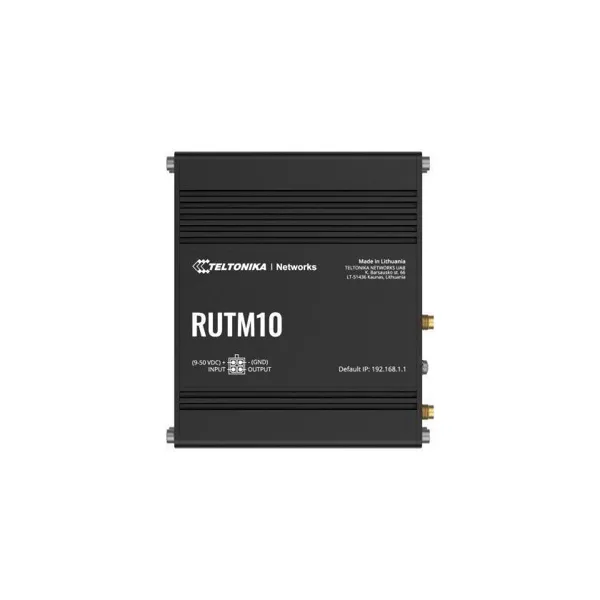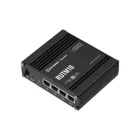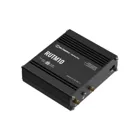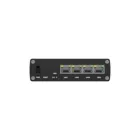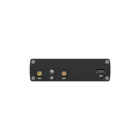RUTM10 - WLAN router, 4 Gigabit RJ45 ports, Wi-Fi 5 connectivity options
The RUTM10 is a wired router with four Gigabit RJ45 ports and Wi-Fi 5 connectivity options. This makes it ideal for applications that require both wired connections and a wireless access option for Internet access. The RUTM10 can set up a Wi-Fi mesh network within your network solutions, enabling a smoother and more robust wireless network experience that is highly secure thanks to the router's support for VPNs such as OpenVPN, IPsec, Wireguard and Tailscale.
WIRELESS
- Wireless mode: 802.11b/g/n/ac Wave 2 (WiFi 5) with data transfer rates up to 867 Mbps (dual band, MU-MIMO), 802.11r Fast Transition, Access Point (AP), Station (STA)
- Wi-Fi security: WPA2-Enterprise - PEAP, WPA2-PSK, WPA-EAP, WPA-PSK, WPA3-SAE, WPA3-EAP, OWE; AES-CCMP, TKIP, auto-cipher modes, client separation, EAP-TLS with PKCS#12 certificates, deactivation of Auto-Reconnect
- SSID/ESSID: ESSID stealth mode
- Wi-Fi users: Up to 150 simultaneous connections
- Wireless connectivity features: Wireless Mesh (802.11s), Fast Roaming (802.11r), BSS Transition Management (802.11v), Radio Resource Metering (802.11k)
- Wireless MAC Filter: Whitelist, Blacklist
- Wireless QR Code Generator: Once scanned, a user is automatically let into your network without having to enter any credentials.
ETHERNET
- WAN: 1 x WAN port 10/100/1000 Mbps, compliance with IEEE 802.3, IEEE 802.3u, 802.3az standards, supports Auto-MDI/MDIX crossover
- LAN: 3 x LAN ports, 10/100/1000 Mbps, compliance with IEEE 802.3, IEEE 802.3u, 802.3az standards, supports Auto-MDI/MDIX crossover
NETWORK
- Routing: Static routing, dynamic routing (BGP, OSPF v2, RIP v1/v2, EIGRP, NHRP), policy-based routing
- Network protocols: TCP, UDP, IPv4, IPv6, ICMP, NTP, DNS, HTTP, HTTPS, SFTP, FTP, SMTP, SSL/TLS, ARP, VRRP, PPP, PPPoE, UPNP, SSH, DHCP, Telnet, SMPP, SNMP, MQTT, Wake On Lan (WOL)
- VoIP passthrough support: H.323- and SIP-alg protocol NAT helpers that enable the correct routing of VoIP packets
- Connection monitoring: Ping reboot, Wget reboot, periodic reboot, LCP and ICMP for link inspection
- Firewall: Port forwarding, traffic rules, user-defined rules
- Firewall status page: Display all firewall statistics, rules and rule counters
- Ports management: display device ports, enable and disable individual ports, enable or disable automatic configuration, change transmission speed, etc.
- Network topology: Visual representation of your network showing which devices are connected to which other devices
- DHCP: Static and dynamic IP assignment, DHCP relay, DHCP server configuration, status, static leases: MAC with wildcards
- QoS / Smart Queue Management (SQM): Traffic priority queuing by source/destination, service, protocol or port, WMM, 802.11e
- DDNS: Supports >25 service providers, others can be configured manually
- Network backup: Wi-Fi WAN, VRRP, wired options, any of which can be used as automatic failover
- Load balancing: Balancing Internet traffic across multiple WAN connections
- Hotspot: Captive portal (hotspot), internal/external Radius server, Radius MAC authentication, SMS authorisation, internal/external landing page, walled garden, user scripts, URL parameters, user groups, individual user or group restrictions, user management, 9 default customisable themes and the ability to upload and download custom hotspot themes
- SSHFS: Ability to mount remote file systems via the SSH protocol
- VRF support: first support for virtual routing and forwarding (VRF)
SECURITY
- Authentication: pre-shared key, digital certificates, X.509-certificates, TACACS+, Radius, blocking of IP and login attempts, time-based login blocking, built-in random password generator
- Firewall: Pre-configured firewall rules can be activated via WebUI, unlimited firewall configuration via CLI; DMZ; NAT; NAT-T
- Attack protection: DDOS protection (SYN flood protection, SSH attack protection, HTTP/HTTPS attack protection), port scan protection (SYN-FIN, SYN-RST, X-mas, NULL flags, FIN scan attacks)
- VLAN: Port and tag-based VLAN separation
- WEB filter: blacklist for blocking unwanted websites, whitelist for specifying only permitted websites
- Access control: flexible access control of SSH, web interface, CLI and Telnet
VPN
- OpenVPN: multiple clients and a server can run simultaneously, 27 encryption methods
- OpenVPN encryption: DES-CBC 64, RC2-CBC 128, DES-EDE-CBC 128, DES-EDE3-CBC 192, DESX-CBC 192, BF-CBC 128, RC2-40-CBC 40, CAST5-CBC 128, RC2-64-CBC 64, AES-128-CBC 128, AES-128-CFB 128, AES-128-CFB1 128, AES-128-CFB8 128, AES-128-OFB 128, AES-128-GCM 128, AES-192-CFB 192, AES-192-CFB1 192, AES-192-CFB8 192, AES-192-OFB 192, AES-192-CBC 192, AES-192-GCM 192, AES-256-GCM 256, AES-256-CFB 256, AES-256-CFB1 256, AES-256-CFB8 256, AES-256-OFB 256, AES-256-CBC 256
- IPsec: IKEv1, IKEv2, with 14 encryption methods for IPsec (3DES, DES, AES128, AES192, AES256, AES128GCM8, AES192GCM8, AES256GCM8, AES128GCM12, AES192GCM12, AES256GCM12, AES128GCM16, AES192GCM16, AES256GCM16)
- GRE: GRE tunnels, GRE tunnels via IPsec support
- PPTP, L2TP: client/server instances can run simultaneously, L2TPv3, L2TP via IPsec support
- Stunnel: proxy for adding TLS encryption functionality to existing clients and servers without changes to the programme code
- DMVPN: Method for building scalable IPsec VPNs
- SSTP: Support for SSTP client instances
- ZeroTier: ZeroTier VPN client support
- WireGuard: WireGuard VPN client and server support
- Tinc: Tinc provides encryption, authentication and compression in its tunnels. Client and server support.
- Tailscale: Tailscale offers speed, stability and simplicity over traditional VPNs. Encrypted point-to-point connections using the WireGuard open source protocol
OPC UA
- Supported modes: Client, Server
- Supported connection types: TCP
MODBUS
- Supported modes: Server, Client
- Supported connection types: TCP, USB
- User-defined registers: MODBUS TCP user-defined register block requests that can be read/written to a file within the router and used to extend MODBUS TCP client functionality
- Supported data formats: 8-bit: INT, UINT; 16-bit: INT, UINT (MSB or LSB first); 32-bit: float, INT, UINT (ABCD (big-endian), DCBA (little-endian), CDAB, BADC), HEX, ASCII
DATATO SERVER
- Protocol: HTTP(S), MQTT, Azure MQTT
- Data to server: Extracts parameters from multiple sources and different protocols and sends them all to a single server
MQTTGATEWAY
- Modbus MQTT Gateway: Enables commands to be sent and data to be received from the MODBUS server via the MQTT broker
DNP3
- Supported modes: station, outstation
- Supported connections: TCP, USB
DLMS
- DLMS support: DLMS - Standard protocol for exchanging meter data
- Supported modes: Client
- Supported connection types: TCP, USB
API
- Support for Teltonika Networks Web API (beta): Extend the capabilities of your device by using a range of configurable API endpoints to retrieve or modify data. For more information, see this documentation: https://developers.teltonika-networks.com
MONITORING & MANAGEMENT
- WEB UI: HTTP/HTTPS, status, configuration, FW update, CLI, troubleshooting, multiple event log servers, availability notifications for firmware updates, event log, system log, kernel log, internet status
- FOTA: Firmware update from server, automatic notification
- SSH: SSH (v1, v2)
- Email: Email notification of the status of various services
- TR-069: OpenACS, EasyCwmp, ACSLite, tGem, LibreACS, GenieACS, FreeACS, LibCWMP, Friendly tech, AVSystem
- MQTT: MQTT Broker, MQTT Publisher
- SNMP: SNMP (v1, v2, v3), SNMP Trap
- JSON-RPC: Management API via HTTP/HTTPS
- RMS: Teltonika Remote Management System (RMS)
IOTPLATFORMS
- Cloud of Things: Enables monitoring of: Device name, HW version, serial number, FW version, WAN IP. Enables actions from the cloud: FW update, restart
- Cumulocity: Enables monitoring of: Device name, HW version, serial number, FW version, WAN IP. Enables actions from the cloud: FW update, restart
- Azure IoT Hub: Enables monitoring of: Wan IP, number of bytes sent/received, model, manufacturer, serial number, revision, FW version and collected data from industrial devices
SYSTEM SPECIFICATIONS
- CPU: MediaTek, dual-core, 880 MHz, MIPS1004Kc
- RAM: 256MB, DDR3
- FLASH memory: 16MB serial NOR flash, 256MB serial NAND flash
FIRMWARE/ CONFIGURATION
- WEB UI: Update FW from file, check FW on server, configuration profiles, configuration backup
- FOTA: Update FW
- RMS: Update FW/configuration for multiple devices at once
- Maintain settings: Update FW without losing the current configuration
- Reset factory settings: A full factory reset restores all system settings, including IP address, PIN and user data, to the manufacturer's default configuration
FIRMWARECUSTOMISATION
- Operating system: RutOS (OpenWrt based Linux OS)
- Supported languages: Busybox shell, Lua, C, C++
- Development tools: SDK package with build environment provided
- GPL customisation: you can create your own custom firmware and website application by changing colours, logos and other elements in our firmware to suit your needs or those of your customers
USB
- Data rate: USB 2.0
- Applications: Samba sharing, USB-to-serial
- External devices: possibility to connect an external hard drive, a flash drive, an additional modem, a printer, a USB-to-serial adapter
- Storage formats: FAT, FAT32, exFAT, NTFS (read-only), ext2, ext3, ext4
INPUT / OUTPUT
- Input: 1 x digital input, 0 - 6 V are recognised as logic low, 8 - 50 V are recognised as logic high
- Output: 1 x digital output, open collector output, max. output 50 V, 300 mA
- Events: Email, RMS
- I/O juggler: Allows specific I/O conditions to be set to trigger events
POWER
- Connection: 4-pin industrial DC socket
- Input voltage range: 9 - 50 VDC, reverse polarity protection, overvoltage protection >51 VDC 10us max
- PoE (passive): Power supply option via LAN1 port, not compatible with IEEE802.3af, 802.3at and 802.3bt, mode B, 9 - 50 VDC
- Power consumption: Idle: < 3.51 W, Max: < 8.65 W
PHYSICAL INTERFACES
- Ethernet: 4 x RJ45 ports, 10/100/1000 Mbps
- I/Os: 1 x digital input, 1 x digital output on 4-pin power connector
- Status LEDs: 8 x LAN status, 1 x power LED, 2 x 2.4G and 5G Wi-Fi LEDs
- Power supply: 1 x 4-pin power connector
- Antennas: 2 x RP-SMA for Wi-Fi
- USB: 1 x USB-A port for external devices
- Reset: Restart/user default reset/factory reset button
- Miscellaneous: 1 x earthing screw
PHYSICAL SPECIFICATIONS
- Housing material: anodised aluminium housing and plates
- Dimensions (W x H x D): 115 x 32.2 x 95.2 mm
- Weight: 359 g
- Mounting options: DIN rail, wall mounting, flat surface (all require additional kit)
OPERATING ENVIRONMENT
- Operating temperature: -40 °C to 75 °C
- Operating humidity: 10 % to 90 % non-condensing
- Protection class: IP30
REGULATORY & TYPE APPROVALS
- Regulatory: WEE
EMC EMISSIONS & IMMUNITY
- Standards: EN 55032:2015 + A11:2021, EN 55035:2017 + A11:2020, EN IEC 61000-3-2:2019 + A1:2021, EN 61000-3-3:2013 + A1:2019 + A2:2021, EN 301 489-1 V2.2.3, EN 301 489-3 V2.1.1, EN 301 489-17 V3.2.4, EN 301 489-52 V1.2.1
- ESD: EN 61000-4-2:2009
- Radiation immunity: EN IEC 61000-4-3:2020
- EFT: EN 61000-4-4:2012
- Immunity to overvoltages (AC mains connection): EN 61000-4-5:2014 + A1:2017
- CS: EN 61000-4-6:2014
- DIP: EN IEC 61000-4-11:2020
RF
- Standards: EN 301 908-1 V15.2.1, EN 301 908-2 V13.1.1EN 301 908-13 V13.2.1, EN 300 328 V2.2.2, EN 301 893 V2.1.1, EN 300 440 V2.2.1
SAFETY
- Standards: CE: EN IEC 62368-1:2020 + A11:2020, EN IEC 62311:2020, RCM: AS/NZS 62368.1:2022, CB: IEC 62368-1:2018
